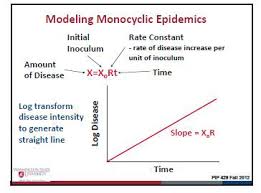
Forecast based on initial inoculumn
EXAMPLES OF PLANT DISEASE
FORECAST SYSTEMS
Generally, it is useful to have the maximum amount of information that is available about a disease before venturing to predict its development. In many cases,
however, one or two of the factors that affect disease
development predominate so much that knowledge of
them is often sufficient for the formulation of a reasonably
accurate forecast. Thus, forecasting systems of
several plant diseases use the amount of the initial inoculum
as the criterion. Such diseases include Stewart’s wilt
of corn, blue mold of tobacco, fire blight of apple and
pear, pea root rot, and other diseases caused by soilborne
pathogens such as Sclerotium and cyst nematodes.
Forecasting systems of diseases such as the late blight of
potato, Cercospora and other leaf spots and the downy
mildew of grape use the number of infection cycles or
the amount of secondary inoculum as the criterion.
Forecasting systems of still other diseases, e.g., apple
scab, black rot of grape, cereal rusts, Botrytis leaf blight
and gray mold, and sugar beet yellows, use the amount
of the initial inoculum and the number of infection
cycles or the amount of secondary inoculum as criteria.
Forecasts Based on Amount of Initial Inoculum
In Stewart’s wilt of corn [caused by the bacterium
Erwinia (Pantoea) stewartii], the pathogen survives the
winter in the bodies of its vector, the corn flea beetle.
Therefore, the amount of disease that will develop in a
growing season can be predicted if the number of
vectors that survived the previous winter is known, as
that allows an estimation of the amount of inoculum
that also survived the previous winter. Corn flea beetles
are killed by prolonged low winter temperatures. Therefore,
when the sum of the mean temperatures for the
three winter months December, January, and February
at a given location is less than -1°C, most of the beetle
vectors are killed and so there is little or no bacterial
wilt during the following growth season. Warmer
winters allow greater survival of beetle vectors and proportionately
more severe wilt outbreaks the following
season.
In the downy mildew (blue mold) of tobacco (caused
by the oomycete Peronospora tabacina), the disease in
most years is primarily a threat to seedbeds in the
tobacco-producing states. When January temperatures
are above normal, blue mold can be expected to appear
early in seedbeds in the following season and to cause
severe losses. However, when January temperatures are
below normal, blue mold can be expected to appear late
in seedbeds and to cause little damage. If the disease is
expected in seedbeds, control measures can be taken to
prevent it from becoming established, and subsequent
control in the field is made much easier. Since 1980, a
supplementary blue mold warning system has been
operated in North America by the Tobacco Disease
Council and the Cooperative Extension Service. The
warning system keeps the industry aware of locations
and times of appearance and spread of blue mold and
helps growers with the timing and intensity of controls.
In pea root rot (caused by the oomycete Aphanomyces
euteiches) and in other diseases caused by soilborne
fungi and some nematodes, the severity of the disease in
a field during a growing season can be predicted by
winter tests in the greenhouse. In these tests, susceptible
plants are planted in the greenhouse in soil taken from
the field in question. If the greenhouse tests show that
severe root rot develops in a particular soil, the field
from which the soil was obtained is not planted with the
susceptible crop. However, fields whose soil samples
allow the development of little or no root rot can be
planted and can be expected to produce a crop reasonably
free of root rot. With some soilborne pathogens,
such as fungi Sclerotium and Verticillium and the cyst
nematodes Heterodera and Globodera, the initial inoculum
can be assessed directly by isolating the fungal sclerotia
and nematode cysts and then counting them per
gram of soil. The greater the number of propagules, the
more severe the disease produced.
In fire blight of apple and pear (caused by the bacterium
Erwinia amylovora), the pathogen multiplies
much more slowly at temperatures below 15°C than at
temperatures above 17°C. In California, a disease outbreak
can be expected to occur in the orchard if the daily
average temperatures exceed a “disease prediction line”
obtained by drawing a line from 16.7°C on March 1 to
14.4°C on May 1. Therefore, when such conditions
occur, application of a bactericide during bloom is indicated
to prevent an epidemic.


